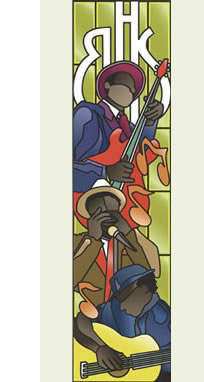
|
|
|
Friday,
October 19th
Saturday, October 20th, 2007
|
Blue Heaven
Studios
201 S. Eighth Street
Salina, Kansas 67401
785-825-8609 |
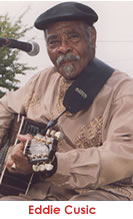 Eddie
Cusic Eddie
Cusic
Eddie Cusic, also known as "Eddie Q," was
born in Wilmot, Mississippi in 1926. As a 12 year old, he fashioned
a strand of bailing wire to a wall on his family's farm and using
a broken bottleneck, created a lyrical whining effect on the
strings of this homemade diddly-bow. He'd heard blues performed
at suppers and community get-togethers. At age 15, Cusic bought
himself a six-string acoustic Gene Autry model guitar and his
studies increased in seriousness.
At the beginning of the 1950s, Cusic formed a three-piece band called the Rhythm
Aces that included then-unknown Little Milton Campbell. The group played clubs
in Leland and Greenville, Mississippi and at juke joints in the surrounding countryside.
The band split when Cusic joined the army in 1952. Later, as Campbell gained
fame, he often attested to the early influence Cusic had on his guitar playing.
Coming out of the service, Cusic settled in Stoneville, Mississippi where
he worked in a Ford automobile plant and at a USDA meatpacking plant. He
later worked at a quarry. While his focus had shifted from music to supporting
his family through the more conventional day jobs, Cusic never did give
up on his playing, and he still performed at area venues and festivals,
often teaming with guitarist James "Son" Thomas. In just the last decade,
Cusic retired from those day jobs and is finally available as a full-time
musician. A renewed interest in American roots music has brought well-deserved
attention to Cusic's traditional playing style. He recorded his long-overdue
debut in 1998, titled I Want To Boogie,
for Hightone Records.
"I come up the hardest way you can think," Cusic says. "I think about hard times
is how I get my blues."
 Henry Gray Henry Gray
He returned to his native Louisiana in 1968 and in plenty of time to become
known as one of the greatest of that rich blues scene, but Henry Gray made
his truly indelible mark on the blues while in Chicago in the 1950s and
'60s. In those days, Gray was in the company of Otis Spann and Sunnyland
Slim as the most in-demand players of the time. And of course a 12-year
run with the great Howlin' Wolf forever secured Gray's place in blues history.
Gray was born in January 1925 in Kenner, Louisiana to parents who encouraged
their son's interest in piano but forbade his passion for the blues. By age 15,
Gray had secretly advanced himself to the point of securing a paying gig. He
finally got the nerve to tell his father he aimed to be a bluesman. "When my
father saw that I could make money playing the blues, he liked it alright," Gray
recalls.
Gray arrived in Chicago in 1946, fresh from a stint in the Philippines during
World War II. Strongly influenced by barrelhouse master Big Maceo Merriwether,
Gray's rapidly escalating talents were soon in heavy demand. After starting out
with Little Hudson's Red Devil Trio, Gray appeared on classic sides by Jimmy
Reed, Bo Diddley, Jimmy Rogers, Little Walter, Billy Boy Arnold and Morris Pejoe
before joining the Wolf in 1956. He can also be heard on many of J.D. Miller's
Louisiana Excello recordings of the '50s and '60s.
Gray left Wolf's band in 1968 and returned to Alsen, Louisiana to help his mother
with a family fish market business shortly after his father had died. He didn't
stay out of music long, however, and has for the past 40 years stayed busy on
the international festival and club circuit. Since 1988, he's made at least six
recordings as a bandleader.
 Chicago
Bob Nelson Chicago
Bob Nelson
He was born in Louisiana, probably is best known in Atlanta
and now lives in Boston, but in the 1960s, Bob Nelson was mostly found in
Chicago's blues clubs. So steady was Nelson's attendance on each end of
the city that Muddy Waters took to calling him "Chicago Bob."
Born in Bogalusa, Louisiana in 1944, Nelson's family became dairy farmers
in a move to Kentwood, Louisiana when he was around 10. Nelson's father,
who played harmonica and upright bass, was friends with musicians Lazy Lester,
Slim Harpo, Lightnin' Slim and Silas Hogan. The young boy learned from visiting
musicians and heard Zydeco, Cajun, Swamp Pop and blues at barbeques. By
age 8, he was playing harmonica.
Nelson spent his childhood summers visiting an aunt in Chicago. He was too
young to get into the clubs, but he heard Jimmy Rogers, Big Walter Horton,
Johnny Shines and others on Maxwell Street. He'd listen diligently to the
music and then rush to his aunt's house to try to recreate the sounds on
his harmonica. In the mid-1960s, Nelson moved to Chicago and became a fixture
at the clubs, sitting in and occasionally touring with Waters, Howlin' Wolf,
Earl Hooker, Buddy Guy, Junior Wells and JB Hutto.
In 1965, Nelson joined the band of Luther "Georgia Boy" "Snake" Johnson
and moved with him to Boston. For the next 10-plus years, Nelson was a regular
in Johnson's outfit though he'd regularly leave to join John Lee Hooker
or Muddy Waters on the road. When Johnson died in 1976, Nelson took over
his band. A couple years later he moved to Atlanta, a city he liked since
visiting on tours with John Lee Hooker.
Nelson became the lead singer and harp player for the Heartfixers, a band
that featured Tinsley Ellis on guitar. He stayed with that group for five
years, recording two albums. In 1986, Nelson actually helped in the physical
construction of Atlanta blues club Blind Willie's. Shortly after it opened
he led the house band all the way until 2000. During that period, he recorded
for the King Snake, Wild Dog and Planis Phare labels.
Health problems stalled Nelson's career for a couple of
years. After recovering from heart surgery in 2002, Nelson moved back to
Boston where he performs regularly and recorded Flyin' Too High for
95North Records in 2006.
 Lazy
Lester Lazy
Lester
Leslie Johnson was born June 20, 1933 in the small town
of Torras, Louisiana and was raised mostly in Scotlandville, a suburb of Baton
Rouge. As a boy, he worked at a grocery store, where he purchased a harmonica
and Little Walter's famous "Juke" record. Lester began to blow harp
and later learned to strum his brother's guitar.
It was in the mid-1950s that fate turned Lester's way. Lester was living
in Rayne, Louisiana at the time and was on the bus riding home. Lightnin'
Slim, who was already an established recording artist, was also on the bus
and was headed to Crowley to cut a record at Jay Miller's Studio, where
so much of the material for the Nashville-based Excello Records was being
recorded. Lester stayed on the bus and accompanied Slim to the studio. When
they got there, the scheduled harp player didn't show for the session. Lester
told Slim that he thought he could handle the harp parts for the session.
Remarkably, Slim and Miller gave Lester that chance, and he did not disappoint.
A classic pairing was born, and Lester became a mainstay on Slim's Excello
recordings and his gigs.
Miller was impressed by Lester's work, and in 1957 Lester debuted as a lead
artist on Excello. Before Lester's debut record release, Miller had
decided that "Lazy Lester" had more of a ring to it than "Lester
Johnson." Lester's first legitimate hits came in 1958 with the
release of "I'm A Lover Not A Fighter" backed with "Sugar
Coated Love." Those two songs established Lester as a star. He
hit again with the follow-up record, "I Hear You Knockin'"/"Through
The Goodness of My Heart." Lester remained a regular Excello artist,
making 15 records for the company.
In 1975, Lester moved to Pontiac, Michigan. He retired from music until
the late '80s when he recorded Lazy Lester Rides Again for the
Blue Horizon label, winning a W.C. Handy Award. That led to a deal with
Alligator Records. Since, he's recorded twice for Antone's and one direct-to-disc
for APO Records.
The Muddy Waters Band
featuring
Pinetop Perkins, Steady Rollin' Bob Margolin, Willie "Big Eyes" Smith and Calvin "Fuzz" Jones
Pinetop Perkins
Pinetop Perkins has made a living playing
blues since 1926. He's created a style that's influenced three generations of
piano players.
Born Joe Willie Perkins in Belzoni, Mississippi in 1913,
this great piano master actually started out playing guitar at house parties
and honky tonks. One very rough gig in the 1940s forced Perkins to switch
instruments. Perkins was performing at a club where, earlier, a man had
locked his girlfriend in the bathroom. When the woman finally escaped, knife
in hand, Perkins, who was on break, was the first person she saw. She hacked
away, causing serious tendon damage in Perkins forearm and ending his ability
to properly grip a guitar.
Perkins switched to piano and came under the tutelage of
Clarence "Pinetop" Smith, who with "Pinetop's Boogie" had
one of the more popular tunes from the boogie-woogie era. Perkins started
performing the song himself and eventually started using the name "Pinetop."
Perkins worked primarily in the Mississippi Delta throughout the '30s and
'40s and spent five years with Rice Miller on the King Biscuit Time radio
program on KFFA in Helena, Arkansas. He also toured extensively with Robert
Nighthawk and backed him on an early Chess session. After briefly working
with B.B. King in Memphis, Perkins barnstormed the South with Earl Hooker
during the early '50s. The pair recorded for Sam Phillips' famous Sun Records
in Memphis in 1953.
But Pinetop is perhaps best known for holding down the piano chair in the
great Muddy Waters Band for 12 years, replacing Otis Spann in 1969. Pinetop
helped shape the Waters' sound of the 1970s with his brilliant piano solos.
In 1980, Perkins and other band members left Waters to form the Legendary
Blues Band. Perkins left Legendary earlier than the others to finally, after
all those years as a sideman, concentrate on a solo career. Since, he's
recorded extensively, been featured on many nationally syndicated news and
music shows, appeared in numerous movies and headlined nearly every major
blues event worldwide.
Steady Rollin' Bob Margolin
There are no musicians better qualified to continue the
tradition of Chicago Blues than those who learned directly at the feet of
the masters. And Steady Rollin' Bob Margolin learned from the master.
From 1973 to 1980, Margolin played guitar in the band of Muddy Waters, touring
and recording and learning to play Muddy's music exactly as Muddy wished.
The lessons were not polite nor were they gentle, but they most certainly
have been enduring.
Margolin was born in Boston in 1949 and raised in nearby Brookline, Massachusetts.
Inspired by Chuck Berry, he started playing guitar in 1964 and soon joined
a rock band. He followed the path of Berry back to the blues and was especially
taken by the music of Muddy Waters.
In August 1973, Margolin went to a Muddy show at Paul's Mall in Boston.
Muddy had seen Margolin in opening acts previously and knew that the younger
guitarist was trying to learn the "old school" style. Muddy had
just lost long-time guitarist Sammy Lawhorn and hired Margolin basically
on the spot. Margolin dedicated himself to giving Muddy what he wanted on
the bandstand. In fact, Muddy grew to trust Margolin to be the conduit between
their style and unfamiliar musicians, bringing Margolin with him on special
gigs like the Band's Last Waltz concert, and recording sessions
like The Muddy Waters Woodstock Album, when the rest of the band
stayed behind. All the while Margolin absorbed – on the stage, in the studio,
from the informal lessons and scolding.
In 1980, Muddy's band dissolved over business problems. Margolin formed
his own band and applied the lessons he'd learned. He's since recorded as
a leader for the Powerhouse, Alligator, Blind Pig, Telarc and Steady Rollin'
Records. He maintains a packed touring schedule, produces reissues of Muddy's
late-'70s Blue Sky albums for Sony/Legacy and is also a senior writer for Blues
Revue magazine.
Willie "Big
Eyes" Smith
Willie "Big
Eyes" Smith was born in Helena, Arkansas in 1936. At the age of 17 he ventured
to Chicago where he saw his first Muddy Waters performance. He was so taken by
the music that he stayed in Chicago and picked up the harmonica.
In 1954, Smith formed a trio with drummer Clifton James and gigged around the
city for a few years. Around the same time, he played harp in the groups of several
other artists, including Johnny Shines, Arthur "Big Boy Spires" and
Bo Diddley. That's Smith's harp work on Diddley's 1955 classic "Diddy Wah
Diddy."
Smith got to know Waters and was inspired to learn drums by Fred Below, Waters'
drummer at the time. In 1957, he switched from harp to drums in Little Hudson's
Red Devil Trio. And after gigs or between sets, Smith started to sit in on drums
with Waters' band. Waters invited Smith play drums on a 1959 recording session
and in 1961, Smith replaced Francis Clay as Waters' fulltime drummer.
The mid-'60s were lean times for the blues, and Smith found himself working in
a restaurant, driving a cab and collecting welfare. He packed his drum kit in
the closet for several years. One night in 1968, Smith decided to attend
a Waters performance. He asked to sit in with the band, and the next day, Waters
asked Smith to rejoin him for another historic run that lasted until 1980.
Smith then co-founded the Legendary Blues Band with Pinetop Perkins, Louis Myers,
Calvin "Fuzz" Jones and Jerry Portnoy. The group was nominated for
six Grammy awards, recorded four critically acclaimed albums on the Ichiban label,
backed up Buddy Guy, Howlin' Wolf and Junior Wells, toured with Bob Dylan, the
Rolling Stones and Eric Clapton and appeared in the movie The Blues Brothers as
street musicians backing John Lee Hooker.
Calvin "Fuzz" Jones
As the bass player for the Muddy Waters Band for nearly two decades,
Calvin "Fuzz" Jones laid the bedrock for some of the best blues ever performed.
Along with Pinetop Perkins, Willie "Big Eyes" Smith and Bog Margolin, Jones
formed what was essentially the final Muddy Waters Band. They worked behind
the master until 1980 when they left to form the Legendary Blues Band, a
project that Jones and Smith continued to lead into the 1990s. The collective
rhythmic feel and personality of Jones, Perkins, Margolin and Smith became
synonymous with Chicago Blues and has made each of those men a legend in
their own right.
Born in 1926 in Greenwood, Mississippi, Jones learned to play the violin and
bass guitar at an early age. His music took him to Chicago where Jones worked
with Waters, Howlin' Wolf, James Cotton, Big Daddy Kinsey, Kim Wilson, Snooky
Pryor, Otis Spann and many others.
He's since returned to his native Mississippi but still works occasionally with
his old cohorts. In 2004, Jones first performed at Blue Heaven Studios as part
of Kenny Wayne Shepherd's 10 Days Out…Blues From The Backroads project.
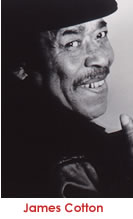 James Cotton James Cotton
The musical pedigree of Grammy Award winner James Cotton
consists of a veritable who's who in the world of the blues. Inducted into
the Blues Hall of Fame in 2006, the Smithsonian Institute in 1991 and winner
of countless W.C. Handy Awards, he has shared the stage with Muddy Waters,
Howlin' Wolf, B.B. King, The Rolling Stones, Johnny Winter, the Allman Brothers,
Santana, Bonnie Raitt, Led Zeppelin, Janis Joplin, Sam and Dave, The Grateful
Dead and many others.
Cotton was born July 1935 in Tunica, Mississippi. He was orphaned at
the age of nine and raised for the next six years by his mentor, Rice
Miller (Sonny Boy Williamson II). As a young teenager, Cotton began
gigging around Memphis with people like Hubert Sumlin, Joe Willie Wilkins
and Willie Nix. He befriended Howlin' Wolf and joined forces with him,
playing Mississippi and Arkansas juke joints for two years. During
that time, Cotton hosted his own afternoon radio show in West Memphis,
Arkansas and also recorded "Cotton
Crop Blues" and "Straighten Up Baby" on Sun Records in 1953.
In 1954, when Muddy Waters needed a harmonica player to replace Little Walter,
he found Cotton playing a club in Arkansas and took him to Chicago. Initially,
Chess Records insisted on continuing to use Little Walter on Muddy's recording
sessions, but finally in 1958 Cotton made his Chess debut backing Muddy
on "She's Nineteen Years Old" and "Close to You."
In 1966, Cotton formed his James Cotton Blues Band, which continues today.
He recorded for Vanguard, Prestige and Loma before making his first full-length
album in 1967 for Verve Records with a band that included guitarist Luther
Tucker and drummer Sam Lay. Cotton has since recorded for Capitol, Alligator,
Blind Pig, Tomato, Telarc and several other labels.
The year 2007 marks Cotton's 63rd as an entertainer. Though throat
problems have ended Cotton's once-ferocious singing voice, he remains a
masterful instrumentalist.
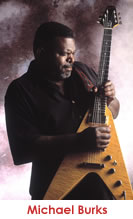 Michael Burks Michael Burks
Michael Burks plows through the blues with relentless power
in a show noted for incendiary burn and sweat-drenched passion. A meaty,
honest guitar tone and real investment in his craft have made Burks one
of the blues world's fastest rising stars.
While he was a W.C. Handy Award nominee in 2000 for Best New Artist, Burks
is in fact a seasoned veteran in every sense. Born in Milwaukee in 1957,
Burks was immediately surrounded by the blues. His father, Frederick Burks,
worked in a Milwaukee steel mill by day and spent his evenings playing bass
in the city's blues clubs, often backing touring legends like Rice Miller.
But the elder Burks' fingers were crushed in a press that made castings
for engine blocks, ending his ability to pick the notes on his bass. Still,
Frederick Burks encouraged his young son by showing him chords on the guitar
and giving him a stack of classic blues 45s from which to listen and learn.
Michael Burks' first gig came at age six, when, during a family trip to
southern Arkansas, Burks took the stage with his cousin's band and thrilled
an unsuspecting audience. When he was 13, Burks visited his mother in California
and won an audition over 20-some other guitarists for a spot in a touring
pop band called Michael Clay & the Fabulous Souls. Shortly thereafter,
Burks and his father returned to his father's native Camden, Arkansas and
opened a juke joint called Bradley Ferry Country Club where Burks played
in the house band four nights a week until the club closed when he was coming
into adulthood.
For the next 13 years, Burks worked a day job as an electronics mechanic
at Lockheed Martin. The weekends were for music, and he used the limited
time he had to build a local following. Finally, in 1993, Burks became a
fulltime bluesman.
After years of performing without a record, Burks released his self-produced
debut, From The Inside Out in 1997, confidently announcing his
intention to take the blues world by storm. Blues Access deemed
the record to be "the most impressive Indie in recent memory." The
gigs and the acclaim have really picked up for Burks since he signed with
Alligator in 2001 and released Make It Rain followed in 2003 with I
Smell Smoke.
Saturday,
October 20
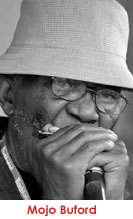 Mojo Buford Mojo Buford
George Buford's nickname comes from perhaps his old boss' most
popular song. In the 1960s, fans requested Buford's version of
the Muddy Waters staple "Got
My Mojo Working" so often that Buford became known simply as "Mojo."
Buford, who was born in 1929 in Hernando, Mississippi, moved to Memphis
when he was 12 and soon took up harmonica after meeting and seeing the performances
of artists like B.B. King and Little Walter.
In 1954, Buford moved to Chicago and formed a group called the Savage Boys.
After meeting Muddy Waters, the group eventually changed its name to the
Muddy Waters Jr. Band and served as the fill-in group for Muddy's Chicago
club gigs when Muddy was on the road. Buford said that while he'd been playing
harmonica and blues for years prior, he didn't "really" learn
the blues until he met Muddy. "Muddy turned my black ass blue," Buford
has said.
In 1959, Buford replaced George "Harmonica" Smith in the Muddy
Waters Band and toured all around the country for the next three years.
One gig came in Minneapolis at the Loon Club. There, Buford was offered
a job as the house act. The money was good, and so he moved to Minneapolis
in 1962 to begin his own group. Around that time, he recorded a couple of
LPs for Vernon and Folk-Art, and this is also when he first adopted the "Mojo" moniker.
Buford returned to Muddy's band in 1967 for a year and then put in a longer
stint in the early 1970s. He then returned to Minneapolis, where he lives
today, and worked with Sonny Rogers, S.P. Leary, Lazy Bill Lucas, Pat Hare,
Pee Wee Madison and others. He returned to Muddy once again in 1980, replacing
Jerry Portnoy and becoming Muddy's last harmonica player.
Buford has recorded as a bandleader for Mr. Blues, JSP, Blue Loon, Fedora
and P-Vine. He still performs regularly and has worked relatively recently
as the singer for James Cotton's outfit.
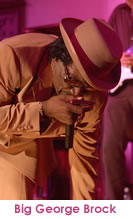 Big George Brock Big George Brock
"You don't hear blues today. You think you do, but you don't. I'm talking
about the younger generation. You're hearing crossover. To me, blues is…I
don't know. Big George Brock. That's about as close – not close –
it is the blues." – Sonny Payne, the regular host of KFFA's King
Biscuit Time radio show in Helena, Arkansas since 1951
Heavyweight Champion of the Missouri Blues Harp, Big George Brock is taking
on all comers. "I am the only musician with a gold belt. Whenever I
look at the belt on the mantel, I feel a sense of pride. I challenge any
musician who thinks they're bad enough to remove it from my waist." Brock
brings that same bravado to the stage.
Born in Grenada County, Mississippi in 1932, Brock did not come from a musical
family. Of his two parents and 16 siblings, he was the only one who pursued
music. His father bought him a harmonica when Brock was nine years old and
by age 12, he was performing at Saturday night fish fries with friends Lee
Kizart and Big Jack Johnson. Brock was also an accomplished boxer in his
youth, not hard to envision when you see this enormous man with catcher-mitt
hands. When Brock cups a harp it looks like King Kong trying not to hurt
the girl.
Brock moved to St. Louis in 1953 and continued as a blues
performer. He soon opened his Club Caravan, which booked acts like B.B.
King, Howlin' Wolf, Muddy Waters, Jimmy Reed, Gatemouth Brown and Albert
King. Brock performed with them all. While he had many opportunities to
record – including with Chess Records – and to tour, he preferred staying
in St. Louis and operating his club. Brock finally closed Club Caravan in
1970, under tragic circumstances. Brock had thrown out an unruly customer.
The man returned with a gun and fired at Brock. The bullets missed and sprayed
through the kitchen wall, hitting and killing Brock's wife. Brock, in his
mourning, closed the club.
Brock didn't make his recording debut until he was in his 60s when he released
a pair of self-produced 45s followed by an LP and a CD reissue. In 2005,
Cat Head Records released Brock's Club Caravan, and in 2006, APO
Records released Heavyweight Blues, recorded at Blue Heaven Studios.
GOIN' TO THE MARDI GRAS
Robert
Parker
Robert Parker knocked the socks off the nation
in 1966 with his smash "Barefootin'," a tune that jumped to No. 2 on the R&B
charts and No. 7 on the Pop charts. Covered by Wilson Pickett, Rufus Thomas,
Johnny Winter, Pee Wee Crayton, Jimmy Buffett, Tommy McLain, Alabama, Barefoot
Jerry, Johnny Rivers, Pete Townshend and a slew of others, it'd have to
be considered a standard by now, 41 years later.
Parker, born in New Orleans in 1930, was actually an accomplished alto
saxophonist before "Barefootin'," having recorded or toured with Earl King,
Fats Domino, Ernie K-Doe, Irma Thomas, Joe Tex, Huey "Piano" Smith,
Frankie Ford and Professor Longhair. In fact, it was Parker who named Fess'
group, "Professor Longhair's Shuffling Hungarians." You can hear
Parker's alto sax on the 1949 Fess hit "Mardis Gras in New Orleans" on
Atlantic. He made his bandleader debut with a regional hit on the Ron label
in 1959 with "All Night Long," a two-part instrumental.
But "Barefootin'," which was released by the NOLA label, unlocked
an easy-delivery, smooth vocal style, making Parker one of the relatively
few New Orleans R&B, soul and funk artists to break beyond regional
acclaim. Parker recorded 11 45s and one LP for NOLA between 1966 and 1968,
though only "Tip Toe" made any additional chart noise, peaking
at No. 48 R&B and No. 83 Pop.
In 1969, Parker moved to Silver Fox Records and later to SSS International.
In the '70s, he signed with Sansu, a label operated by Allen Toussaint,
the incredible musician and producer. Toussaint reunited Parker with Wardell
Quezergue, who had produced Parker's NOLA output, and some fine if under-appreciated
tunes resulted.
Jean Knight
Jean Knight's 1971 no-nonsense ripping of
macho male arrogance took her directly form the kitchen of Loyola
University to a five-week stay at No. 1 on the charts. "Mr. Big Stuff" went
double platinum, and Knight will never be forgotten.
Born in New Orleans in 1943, Knight began performing just out of high
school. She quickly caught the attention of local musicians who were
willing to accompany her. In the mid-1960s, Knight recorded a demo
and submitted it to producer Huey P. Meaux, who then signed her to
his Jet Stream and Tribe labels. The singer adopted the professional
last name "Knight" rather
than go by her harder-to-pronounce birth name of "Caliste."
It seemed a promising career was underway, and indeed Knight did find success
in New Orleans but not beyond the city. She took a day job as a baker at
Loyola University.
Then, in 1970, Knight went to Malaco Studios in Jackson, Mississippi at
the insistence of Ralph Williams, who'd written some songs he wanted her
to record with producer Wardell Quezerque. The key track from the sessions, "Mr.
Big Stuff," was shopped to labels far and wide. Nobody was interested.
But when King Floyd's "Groove Me" – another song recorded at Malaco
– became a No. 1 hit and went Gold, Stax reconsidered and released "Mr.
Big Stuff" in 1971. The song became an instantaneous smash hit, racing
up the charts to No. 1 R&B and No. 2 Pop and garnering a Grammy nomination
for Best R&B Vocal Performance.
Knight's follow-up song, "You Think You're Hot Stuff," also charted
in 1971 (No. 19, Black Singles; No. 57 Pop) and her "Carry On" hit
No. 44 Black Singles in '72.
In 1981, Knight signed with the Soulin' label and recorded "You Got
The Papers (But I Got the Man)," an answer to Betty Wright's "I've
Got the Papers On The Man." Then in 1985, she hit No. 50 on the Pop
chart with her cover of Rockin' Sidney's "My Toot Toot" for the
Mirage label. She recorded for Ichiban in 1997 and for Formaldehyde in '99.
Clarence "Frogman" Henry
Clarence Henry was just messing around when
he first sang in falsetto, "like
a girl," and in a deep, croaky tone, "like a frog." It was
in the early morning hours of a New Orleans club gig in 1956, and the remaining
crowd went crazy. He didn't know it quite yet, but Henry had just sung the
first version of a big-time hit.
Soon after when Paul Gayten, the New Orleans A&R man
for Chess Records, heard Henry's "I Ain't Got No Home" he rushed
Henry into Cosimo Matassa's studio. The song was released on the Chess subsidiary
Argo Records and jumped to No. 3 on the R&B charts and No. 20 on the
Pop charts. New Orleans DJ Poppa Stoppa played the tune repeatedly and introduced
the artist each time as "Frogman." A hit, a nickname and a career
were born.
Henry was born in New Orleans in March 1937. As a teenager, he'd sneak
into clubs to hear his heroes, Professor Longhair and Fats Domino.
He even dressed like Longhair at talent shows, wearing a wig with long
braids on both sides. He joined Bobby Mitchell's group The Toppers
in 1952, playing piano and trombone, and recorded with them for Imperial.
He stayed with The Toppers until 1955 when he began finding jobs as
a lead artist, featuring his singing. When Henry recorded his "I Ain't Got No Home," Rock
'n' Roll was in its infancy, and the song fit perfectly with the day's
trend. Henry became a star at age 19.
Henry recorded prolifically for Argo and had another hit in 1961 with Bobby
Charles' "(I Don't Know Why) But I Do," which reached No. 4 R&B.
Later that year, he hit No. 12 R&B with "You Always Hurt The One
You Love." Several more Henry records charted for Argo and in 1964,
he opened 18 concerts for the Beatles in the U.S. and Canada. He left Argo
later in '64 for Parrot Records and two years later left Parrot for Dial
Records. In 1969, Henry recorded a collection of New Orleans standards for
the Roulette label.
Henry worked constantly on Bourbon Street all they way until 1981 when he
began to tour internationally. He cut his The Legendary Frogman Henry LP
for Silvertone in England in 1982.
ZYDECO BOOGALOO
A set of the best traditional Zydeco from
the genre's living masters, including Major Handy and a backing
band that includes Buckwheat Zydeco and Lil' Buck Sinegal
Major Handy
"A thoughtful, articulate man off-stage, Handy is a whirlwind on it,
shifting gears with breathtaking speed, he can reel off uncanny swatches
of rock, blues, country and soul tangled up in delicious counterpoints of
pure zydeco." - New Orleans Times Picayune
Born in 1949 in the small southeast Louisiana town of St. Martinsville -
smack in the heart of Creole country - Joseph Major Handy's childhood desire
to join in the musical activity that surrounded him was so intense that
in his early teens he constructed a fairly intricate guitar out of a cigar
box and some discarded screen wire. There was music everywhere - in the
neighbor's yards, in the town square, at the local clubs - so there was
certainly no shortage of influences for an aspiring musician. Handy, a sort
of sponge, was soon adept at guitar, bass, piano, accordion and as a vocalist.
Music was his fate, probably before he even realized it.
Handy's early
gigs came mostly on guitar, including a job with Buckwheat Zydeco's original
lineup and then with Rockin' Sidney. He's gone on to become one of today's finest
zydeco and blues accordion players, steeped in the traditional styles of masters
Clifton Chenier and Fernest Arceneaux.
Handy, who is nicknamed the Zydeco Bad Boy, has recorded two albums for GNP as
well as a couple of songs on the Maison de Soul Records release, 100 Proof
Zydeco.
Buckwheat Zydeco
Long before Stanley Dural Jr. became Buckwheat Zydeco and a master of the
accordion, he was known as one of the baddest organ players in south
Louisiana. Tonight, he's going back to his roots, to his first and
most enduring love, the Hammond organ. Along with his first boss, guitarist
Lil' Buck Sinegal, Dural will anchor the backing band for five headliners.
Dural was born in Lafayette, Louisiana in November 1947. He lived with
his parents and 13 siblings in a two-bedroom house with music as the
chief entertainment. When Dural was about 13 years old, he saw a performance
by Paul "Lil'
Buck" Sinegal. Dural introduced himself, mentioned that he owned his
own organ and was soon recruited by Sinegal to join his Lil' Buck and the
Top Cats outfit. The band grew to include a horn section and backup singers
– the works – and toured regionally, playing funk and R&B. Dural stayed
with Sinegal until 1971, when he formed his own band, Buckwheat and the
Hitchhikers, still playing organ and yet to find his singing voice.
In the late '70s, Sinegal asked Dural to join him in Clifton Chenier's Red
Hot Louisiana Band. Initially, Dural resisted any feelings of excitement
about playing zydeco, a leftover youthful rejection of his father's "old
time" music. But Chenier, as he did with seemingly everybody, demonstrated
to Dural the raw energy and passion that zydeco could deliver. Dural began
to study the music seriously and viewed Chenier as his idol and mentor.
In 1979, Dural decided that he, like Chenier, would lead a zydeco band and
play the accordion. He left Chenier and woodshedded for nearly a year to
learn accordion. When he emerged, people didn't know what to make of the
instrument switch. Further complicating his image was Dural's attempt at
singing, something he'd long resisted because of a stuttering problem. But
momentum built fast and by 1981, Dural was booking his first European tours.
Buckwheat Zydeco was born. The group signed a five-album deal with Island
Records and has become today's most popular and commercially successful
zydeco band, a four-time Grammy nominee.
But tonight it's the original Buckwheat the organ player, taking his cues
from Lil' Buck – just like the old days.
Lil' Buck Sinegal
At age 63, Lil' Buck Sinegal's career has spanned more than four decades with
over 300 recordings, including a Grammy-winning effort with Paul Simon's 1987
album Graceland. He's also performed and recorded with Clifton Chenier,
Rockin' Dopsie, Buckwheat Zydeco, Fernest Arceneaux, Barbara Lynn and many others.
Sinegal is in fact one of the most active guitarists alive today – a true road
warrior. He has recorded several albums as a bandleader and in 1999 was inducted
into the Louisiana Blues Hall of Fame. He is making his fifth Blues Masters appearance,
more than any other artist.
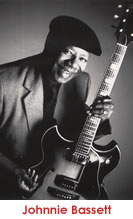 Johnnie Bassett Johnnie Bassett
Johnnie Bassett,
born in Marianna, Florida in 1935, can recall as a boy watching Arthur "Big
Boy" Crudup and Tampa Red play at parties in his grandmother's backyard.
They, along with T-Bone Walker, B.B. King and Albert King, formed the collective
inspiration for Bassett's style of clean, expressive guitar licks.
Bassett's family relocated in 1945 to Detroit where he became a member of the
teenage R&B group Joe Weaver & The Blue Notes in the early 1950s. The
band won so many local talent contest that they could no longer compete as amateurs.
Soon, they were being hired to back visiting artists like Big Joe Turner and
Ruth Brown. After a two-year stint in the Army, Bassett returned to Detroit in
1960 and worked as a session musician for Fortune Records. He also worked gigs
with John Lee Hooker, Lowell Fulson, Dinah Washington, Alberta Adams and others.
In the early 1960s, after traveling to Chicago, Bassett appeared on the very
first recording of Smokey Robinson and the Miracles for Chess Records. Shortly
thereafter, he moved to Seattle to perform with Johnnie "Guitar" Watson
and Tina Turner. He also provided advice and encouragement to a young guitarist
then going by the name Jimmy James but soon to be known as Jimi Hendrix.
Bassett returned to Detroit in the late '60s and raised a family, playing on
weekends behind Chicago Pete, Clarence Price, Little Sonny Willis and Ben Baber.
He formed Johnnie Bassett & The Blues Insurgents in 1992 and has recorded
for the Black Magic, Fedora and Cannonball labels. He continues to tour Europe
and North America.
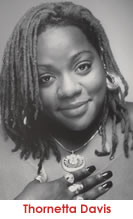 Thornetta Davis
Thornetta Davis
It's a shame that Motown Records is no longer in Detroit
making stars out of local talent because it's easy to envision Thornetta
Davis as another Diana Ross. Davis, with a commanding yet melodic and smooth
voice, is comfortable with all makes of traditional blues, R&B and ballads
and has positioned herself as one of Detroit's brightest stars.
Davis was born in Detroit in 1963 to music-loving parents who boasted
a large record collection. As a child, she was particularly taken by
the Motown radio hits and began singing regularly around her family's
flat. At 15, she sang publicly for the first time at a local talent
show. By 19, she'd joined a Top 40 R&B group, gigging for low pay around
Detroit.
Finally, in 1987 Davis gained some more meaningful attention – and pay –
when she joined the Detroit soul band Lamont Zodiac and the Love Signs as
a backup singer. Soon, the lead singer had left the group and the band changed
names to The Chisel Brothers featuring Thornetta Davis. Davis and the group
played some prominent gigs that included opening slots for artists like
Ray Charles, Gladys Knight, Smokey Robinson, Bonnie Raitt and Etta James.
In 1991, Davis contributed backup vocals to Bob Seger's The Fire Inside
record. Also that year, she began singing backup with the alternative rock
band Big Chief. She recorded two albums with the grunge rockers on the Seattle-based
Sub Pop label. When the group disbanded in 1996, Sub Pop signed Davis as
a lead artist and released her debut, Sunday Morning Music. The
record received very favorable reviews including a rave in the national Entertainment
Weekly magazine. The song "Cry" was featured on the HBO
hit drama The Sopranos.
In 1999, Davis furthered her name with an astounding performance at the
Lillith Fair, hosted by Sarah McLachlan at Michigan's Pine Knob Theatre.
That same evening, she accepted two Detroit Music Awards for Best R&B/Blues
Vocalist and Best R&B Group. Since, her haul of Detroit Music Awards
has grown to 20. In 2000, Davis opened the VH1 Vogue fashion awards at Madison
Square Garden with fellow Detroit star Kid Rock. And in 2001, Davis was
inducted into the Detroit Music Hall of Fame. Davis recorded Live at
the Music Menu in 2003, and the release has increased her national
exposure to where she's now booked more than 200 dates a year. |
|


